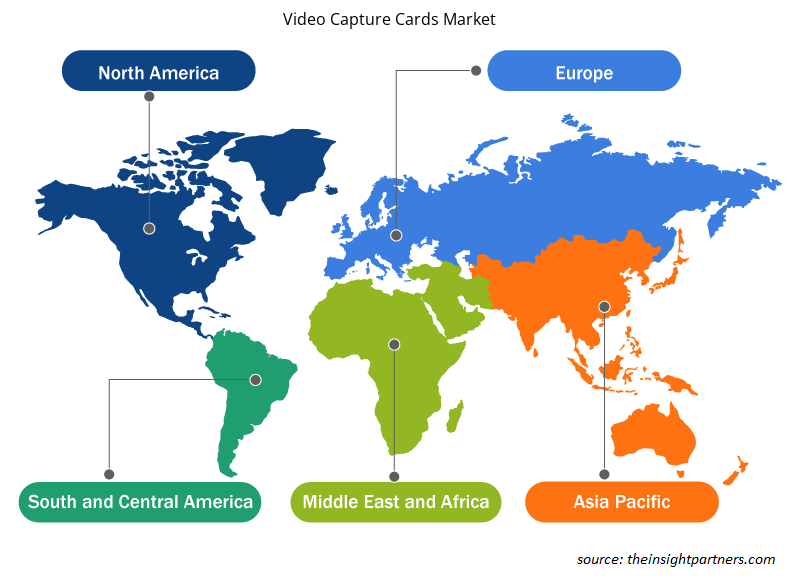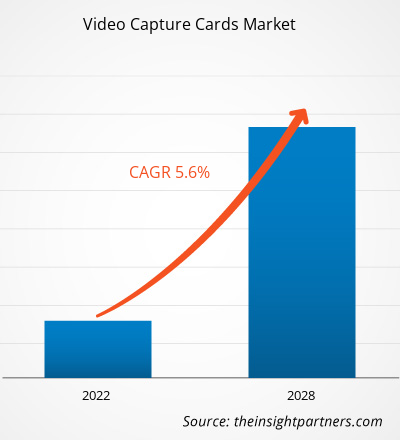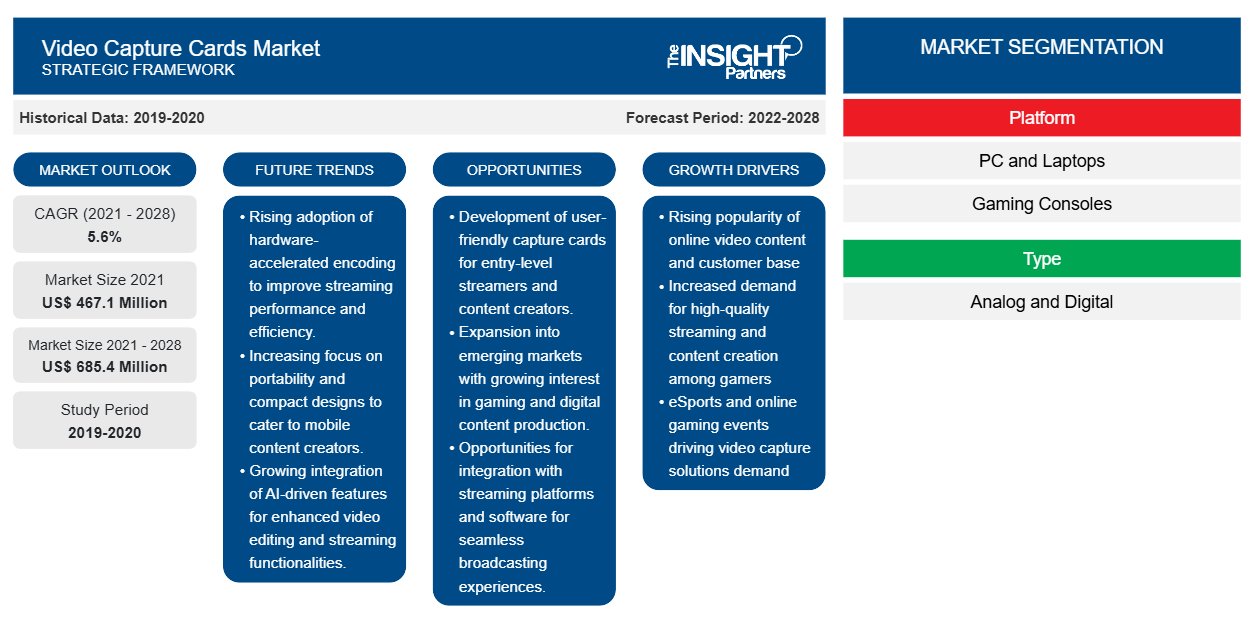Se espera que el mercado de tarjetas de captura de video crezca de US$ 467,1 millones en 2021 a US$ 685,4 millones en 2028; se estima que crecerá a una CAGR del 5,6% entre 2021 y 2028.
El crecimiento del mercado de tarjetas de captura de vídeo se puede atribuir a la creciente popularidad del contenido de vídeo en línea en las plataformas de redes sociales. El aumento de la popularidad de varias plataformas de redes sociales y la posterior transición de varios anuncios y gastos de mercado que convergen en estas plataformas lograron una tracción sin precedentes, particularmente en los últimos años. Además, la creciente tendencia de los influencers de las redes sociales y los videoblogueros profesionales, junto con un notable aumento en el número de vendedores de contenido de vídeo en línea, está impulsando la demanda de contenido de vídeo creativo. Por lo tanto, el contenido de vídeo de calidad mejorada ha facilitado posteriormente la penetración de la tarjeta de captura de vídeo y la aplicación de software, lo que, a su vez, está impulsando el crecimiento del mercado de tarjetas de captura de vídeo. Además, varios actores del mercado han lanzado numerosos programas específicos para teléfonos inteligentes dirigidos a esta base de clientes de rápido crecimiento con la adquisición de tarjetas de captura de vídeo. Por lo tanto, se espera que el aumento de la popularidad de la base de clientes basada en contenido de vídeo en línea, como vendedores de contenido, anunciantes e influencers, proporcione numerosas oportunidades de crecimiento lucrativas para los actores del mercado de tarjetas de captura de vídeo en los próximos años. Sin embargo, las empresas de producción de medios profesionales, como las industrias del entretenimiento, los juegos, los medios de comunicación y los institutos educativos, siguen siendo uno de los principales usuarios finales de las tarjetas de captura de vídeo a nivel mundial. Además, la aparición de varios contenidos de cine y en línea regionales para plataformas OTT en diversos grupos demográficos en países asiáticos y africanos está dando lugar a una demanda de tarjetas de captura de vídeo, lo que, a su vez, impulsará la utilización de tarjetas de captura de vídeo en las economías emergentes.
Personalice este informe según sus necesidades
Obtendrá personalización en cualquier informe, sin cargo, incluidas partes de este informe o análisis a nivel de país, paquete de datos de Excel, así como también grandes ofertas y descuentos para empresas emergentes y universidades.
-
Obtenga las principales tendencias clave del mercado de este informe.Esta muestra GRATUITA incluirá análisis de datos, desde tendencias del mercado hasta estimaciones y pronósticos.
Impacto de la pandemia de COVID-19 en el mercado de tarjetas de captura de vídeo
El impacto de la COVID-19 varió de un país a otro en la región europea, ya que algunos países experimentaron un aumento en el número de casos registrados y, posteriormente, se vieron obligados a aplicar períodos de confinamiento estrictos y más prolongados o aislamiento social. Sin embargo, los países de Europa occidental, como Alemania, Francia, Rusia y el Reino Unido, han experimentado una disminución comparativamente modesta de sus actividades de crecimiento debido al sólido sistema de atención sanitaria. Para proteger a sus ciudadanos del virus, los gobiernos europeos han realizado enormes inversiones en la incorporación de tecnologías en sus sistemas de atención sanitaria para ayudar a identificar los signos del virus.
Debido al brote repentino del virus COVID-19 y a los confinamientos en casi todos los principales países de Europa, la región ha observado un aumento en el consumo de televisión, la creación de carretes para las redes sociales y la adopción de videojuegos entre la población. Durante la pandemia, los juegos de Internet han registrado un número récord de jugadores como una actividad común para combatir la distancia física de la sociedad con la población regional en casa e incapaz de funcionar, una estrategia defendida por la Organización Mundial de la Salud que ha ayudado a muchas empresas de juegos a aumentar las ganancias. Desde el 23 de marzo de 2020, se ha producido un aumento en la cantidad de personas que juegan videojuegos debido a la pandemia de COVID-19 y el consiguiente distanciamiento social. El aumento fue mayor en Francia (41 %), seguido del Reino Unido (28 %) y Alemania (23 %). Esto ha creado una demanda de tarjetas de captura de vídeo en todo el mercado. Sin embargo, debido al cierre temporal de las actividades de fabricación y de la cadena de suministro por parte de los gobiernos locales, la distribución de los accesorios de juego se vio muy afectada, lo que afectó negativamente al mercado general de tarjetas de captura de vídeo en la región.
Perspectivas del mercado: mercado de tarjetas de captura de vídeo
Uso de teléfonos móviles como consola
El uso cada vez mayor de teléfonos inteligentes para grabar y recodificar videos de juegos está haciendo que compita con las consolas de juegos, lo que se puede hacer ya sea llevando los juegos móviles a la TV o transmitiendo los juegos de consola en teléfonos inteligentes. Además, el uso de la cámara de un teléfono inteligente para grabar videos en Instagram Reels, transmisión en vivo y videos de TikTok también está impulsando la adopción de tarjetas de captura de video, para facilitar al usuario la transferencia de datos de manera eficiente a PC y portátiles. Además, los juegos se están convirtiendo en un foco principal para los teléfonos de línea, lo que está atrayendo la atención de los jugadores. Las tarjetas de captura de video se pueden conectar fácilmente con diferentes consolas de juegos como XBOX One, PS3 y PS4. Ayuda a grabar gráficos asombrosos y una resolución impresionante del juego. Los actores del mercado se están centrando en el desarrollo de nuevos procesadores Snapdragon de alto nivel, que tienen el potencial de brindar un rendimiento suficiente en audio, video y gráficos para la consola con juegos de calidad. Sin embargo, es probable que los juegos de alta gama estén en las consolas, mientras que la mayoría de los juegos están disponibles para teléfonos móviles. Por lo tanto, los fabricantes de tarjetas de captura de video para juegos tienen la oportunidad de desarrollar tarjetas de captura de video avanzadas, que sean compatibles con teléfonos inteligentes para grabar videos y jugar juegos.
Perspectivas basadas en plataformas
Según la plataforma, el mercado de tarjetas de captura de video se clasifica en consolas de juegos, PC y portátiles, entre otros. El segmento de consolas de juegos tuvo la mayor participación de mercado en 2020.
Perspectivas basadas en tipos
Según el tipo, el mercado de tarjetas de captura de vídeo se segmenta en digital y analógico. Se prevé que el segmento digital registre una CAGR más alta durante el período de pronóstico.
Información basada en la interfaz de entrada
Según la interfaz de entrada, el mercado de tarjetas de captura de vídeo se segmenta en HDMI, DP, SDI y otros. Se prevé que el segmento Otros registre la CAGR más alta durante el período de pronóstico.
Los actores que operan en el mercado de tarjetas de captura de video se centran principalmente en el desarrollo de productos avanzados y eficientes.
- En 2020, VinBus y Advantech Vietnam colaboraron para promover actividades de cooperación comercial y apoyarse mutuamente en términos de plataformas tecnológicas e instalaciones técnicas.
- En 2020, Advantech e Interlatin poseen el 60% y el 40%, respectivamente, de la nueva filial. La empresa conjunta entra en vigor el 1 de julio de 2020 y se establecen nuevas oficinas en Guadalajara y Ciudad de México.
- En 2021, Datapath desarrolló Aetria, que combina todos los aspectos del diseño, la gestión, el control y la supervisión de la sala de control en una única solución, lo que permite a los integradores y usuarios finales crear sistemas que satisfagan una amplia gama de necesidades, incluida la conectividad, las paredes de video, las estaciones de trabajo y la gestión de fuentes, para instalaciones pequeñas y muy grandes.
Perspectivas regionales del mercado de tarjetas de captura de vídeo
Los analistas de Insight Partners explicaron en detalle las tendencias y los factores regionales que influyen en el mercado de tarjetas de captura de video durante el período de pronóstico. Esta sección también analiza los segmentos y la geografía del mercado de tarjetas de captura de video en América del Norte, Europa, Asia Pacífico, Medio Oriente y África, y América del Sur y Central.

- Obtenga datos regionales específicos para el mercado de tarjetas de captura de video
Alcance del informe sobre el mercado de tarjetas de captura de vídeo
| Atributo del informe | Detalles |
|---|---|
| Tamaño del mercado en 2021 | US$ 467,1 millones |
| Tamaño del mercado en 2028 | US$ 685,4 millones |
| CAGR global (2021-2028) | 5,6% |
| Datos históricos | 2019-2020 |
| Período de pronóstico | 2022-2028 |
| Segmentos cubiertos |
Por plataforma
|
| Regiones y países cubiertos |
América del norte
|
| Líderes del mercado y perfiles de empresas clave |
|
Densidad de actores del mercado de tarjetas de captura de vídeo: comprensión de su impacto en la dinámica empresarial
El mercado de tarjetas de captura de vídeo está creciendo rápidamente, impulsado por la creciente demanda de los usuarios finales debido a factores como la evolución de las preferencias de los consumidores, los avances tecnológicos y una mayor conciencia de los beneficios del producto. A medida que aumenta la demanda, las empresas amplían sus ofertas, innovan para satisfacer las necesidades de los consumidores y aprovechan las tendencias emergentes, lo que impulsa aún más el crecimiento del mercado.
La densidad de actores del mercado se refiere a la distribución de las empresas o firmas que operan dentro de un mercado o industria en particular. Indica cuántos competidores (actores del mercado) están presentes en un espacio de mercado determinado en relación con su tamaño o valor total de mercado.
Las principales empresas que operan en el mercado de tarjetas de captura de vídeo son:
- Tecnología ADLINK Inc.
- Advantech Co. Ltd
- Ruta de datos limitada
- EURESYS SA
- IMPERX, Inc
Descargo de responsabilidad : Las empresas enumeradas anteriormente no están clasificadas en ningún orden particular.

- Obtenga una descripción general de los principales actores clave del mercado de tarjetas de captura de video
El mercado de tarjetas de captura de vídeo se ha segmentado de la siguiente manera:
Mercado de tarjetas de captura de vídeo: por plataforma
- Consolas de juegos
- PC y portátiles
- Otros
Mercado de tarjetas de captura de vídeo: por tipo
- Digital
- Cosa análoga
Mercado de tarjetas de captura de vídeo: por interfaz de entrada
- HDMI
- DP
- IDE
- Otros
Mercado de tarjetas de captura de vídeo por geografía
-
América del norte
- A NOSOTROS
- Canadá
- México
-
Europa
- Alemania
- Francia
- Italia
- Reino Unido
- Rusia
- Resto de Europa
-
Asia Pacífico (APAC)
- Australia
- Porcelana
- India
- Japón
- Corea del Sur
- Resto de APAC
-
Oriente Medio y África (MEA)
- Arabia Saudita
- Emiratos Árabes Unidos
- Sudáfrica
- Resto de MEA
-
América del Sur (SAM)
- Brasil
- Argentina
- Resto de SAM
Mercado de tarjetas de captura de vídeo: perfiles de empresas
- Airbus SAS
- Leonardo SpA
- Campana Textron Inc.
- Tarjeta de captura de vídeo rusa
- Corporación Lockheed Martin
- Boeing
- Corporación de helicópteros Enstrom.
- Corporación Kaman
- Tarjeta de captura de vídeo MD, Inc.
- Compañía de helicópteros Robinson
- Análisis histórico (2 años), año base, pronóstico (7 años) con CAGR
- Análisis PEST y FODA
- Tamaño del mercado, valor/volumen: global, regional y nacional
- Industria y panorama competitivo
- Conjunto de datos de Excel
Informes recientes
Testimonios
Razón para comprar
- Toma de decisiones informada
- Comprensión de la dinámica del mercado
- Análisis competitivo
- Información sobre clientes
- Pronósticos del mercado
- Mitigación de riesgos
- Planificación estratégica
- Justificación de la inversión
- Identificación de mercados emergentes
- Mejora de las estrategias de marketing
- Impulso de la eficiencia operativa
- Alineación con las tendencias regulatorias























 Obtenga una muestra gratuita para - Mercado de tarjetas de captura de vídeo
Obtenga una muestra gratuita para - Mercado de tarjetas de captura de vídeo